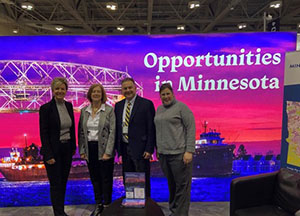Minnesota
Minerals Coordinating Committee
Welcome

Minerals Coordinating Committee delegation welcomed Susan Crystal, Consular General of the US Consulate Toronto to the MCC trade show booth at the 2023 PDAC conference in Toronto, Canada.
The Minerals Coordinating Committee (MCC) is responsible for the management and coordination of Minnesota's Mineral Diversification Program Projects.
The Mineral Diversification Program was created by the Minnesota Legislature in 1987, "To provide for the diversification of the State's mineral economy through long term support of mineral exploration, development, production, and commercialization".
The MCC is a multi-agency committee made up of the following individuals and agencies:
-
Minnesota Department of Natural Resources (MNDNR) - Sarah Strommen, Commissioner
-
Minnesota Pollution Control Agency (MPCA) - Katrina Kessler, Commissioner
-
Iron Range Resources and Rehabilitation Board (IRRRB) - Ida Rukavina, Commissioner
-
Minnesota Geological Survey (MGS) - Tony Runkel, Interim Director
-
University of Minnesota's College of Science and Engineering - Andrew G. Alleyne, Dean
-
Natural Resources Research Institute (NRRI) - Rolf Weberg, Executive Director
-
Four individuals appointed by the governor for a four-year term, one each representing the iron ore and taconite, nonferrous metallic minerals, and industrial minerals industries within the state and one representing labor.
The MCC assists in sponsoring projects that reflect the core objectives of the mineral diversification program. The sponsored projects reflect the statewide benefit of mineral diversification. From sand and gravel to clay, from exploration for gold to taconite processing, virtually every region of the state is enriched by the minerals industry and all share in the use of its products. Of course, a great part of Minnesota's famous quality of life includes environmental health; therefore, the program also gives priority to research that aims to control potentially harmful impacts and enhance post-mining restoration.
The Mineral Diversification Program is well managed and highly successful, a tribute to close cooperation between the state, the University of Minnesota, federal agencies, and the minerals industry. The program's innovative approach to technology has helped keep Minnesota iron and taconite competitive. Research and data collection have helped to make Minnesota an attractive place for mineral exploration and has opened the door to new markets.









